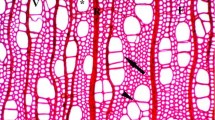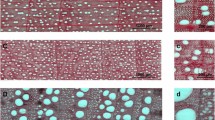Abstract
Key message
By using a simple and rapid technique, the degree of vessel deviations in the stem xylem could be evaluated and compared between different plant species. The degree of vessel deviations was suggested to be one of the main factors determining the hydraulic integration in woody stems.
Abstract
The main objective of this study was to investigate the role of vessel tangential deviations in determining both intervessel connectivity and patterns of hydraulic integration in woody stems of six Fabaceae trees. It was hypothesized that increasing the degree of vessel deviations would increase lateral contacts between vessels thereby increasing hydraulic integration within stems. Species-specific differences in vessel deviations and intervessel connectivity were quantified by following the movement of an apoplastic dye that was injected to a limited number of vessels. Intervessel connectivity was measured as the number of laterally connected vessels, whereas the degree of vessel deviations was measured as the magnitude of divergence of a group of neighboring vessels. Hydraulic integration index was determined as the ratio of tangential to axial conductance. Results showed that the degree of vessel deviations differed significantly between species. Acacia cyanophylla showed the lowest degree of vessel deviations (1.75 ± 0.33), while the highest degree was observed in Acacia etbaica (2.48 ± 0.26). Hydraulic integration was positively correlated more with vessel deviations than with intervessel connectivity. Only a very weak positive correlation was observed between vessel deviations and intervessel connectivity. Tangential deviations in the course of vessels might be one of the main factors determining the patterns of integrated–sectored transport in woody stems and, consequently, might have ecological implications in terms of plant adaptation to various ecological conditions. This study confirmed the complexity of interactions in the xylem hydraulic system.









Similar content being viewed by others
References
Brodersen CR, Choat B, Chatelet DS, Shackel KA, Matthews MA, Mcelrone AJ (2013) Xylem vessel relays contribute to radial connectivity in grapevine stems (Vitis vinifera and V. arizonica; vitaceae). Am J Bot 100:314–321
Burggraaf PD (1972) Some observations on the course of the vessels in the wood of Fraxinus excelsior L. Acta Bot Neer 21:32–47
Chaney WR, Kozlowski TT (1977) Patterns of water movement in intact and excised stems of Fraxinus americana and Acer saccharum. Ann Bot 41:1093–1100
Chiu ST, Ewers FW (1993) The effect of segment length on conductance measurements in Lonicera fragrantissima. J Exp Bot 44:175–181
De Micco V, Aronne G (2008) Wood anatomy and hydraulic architecture of stems and twigs of some Mediterranean trees and shrubs along a mesic-xeric gradient. Trees 22:643–655
Ellmore GS, Zanne AE, Orians CM (2006) Comparative sectoriality in temperate hardwoods: hydraulics and xylem anatomy. Bot J Linn Soc 150:61–71
Fujii T (1993) Application of a resin casting method to wood anatomy of some Japanese Fagaceae species. IAWA J 14:273–288
Fujii T, Hatano Y (2000) The LDPE resin-casting method applied to vessel characterization. IAWA J 21:347–359
Fujii T, Lee SJ, Kuroda N, Suzuki Y (2001) Conductive function of intervessel pits through a growth ring boundary of Machilus thunbergii. IAWA J 22:1–14
Gloser V, Libera K, Orians CM (2008) Contrasting below- and aboveground responses of two deciduous trees to patchy nitrate availability. Tree Physiol 28:37–44
Halis Y, Mayouf R, Benhaddya ML, Belhamra M (2013) Intervessel connectivity and relationship with patterns of lateral water exchange within and between xylem sectors in seven xeric shrubs from the great Sahara desert. J Plant Res 126:223–231
Hargrave KR, Kolb KJ, Ewers FW, Davis SD (1994) Conduit diameter and drought-induced embolism in Salvia mellifera Greene (Labiatae). New Phytol 126:695–705
Jansen S, Gortan E, Lens F, Lo Gullo MA, Salleo S, Scholz A, Stein A, Trifilò P, Nardini A (2011) Do quantitative vessel and pit characters account for ion-mediated changes in the hydraulic conductance of angiosperm xylem? New Phytol 189:218–228
Kanai Y, Fujita M, Takabe K (1996) Vessel network tracing by wire insertion and pigment injection. Bull Kyoto Univ For 68:127–136
Kitin PB, Sano Y, Funada R (2003) Three-dimensional imaging and analysis of differentiating secondary xylem by confocal microscopy. IAWA J 24:211–222
Kitin PB, Fujii T, Abe H, Funada R (2004) Anatomy of the vessel network within and between tree rings of Fraxinus lanuginosa (Oleaceae). Am J Bot 91:779–788
McCulloh KA, Sperry JS (2005) Patterns in hydraulic architecture and their implications for transport efficiency. Tree Physiol 25:257–267
Nadezhdina N (2010) Integration of water transport pathways in a maple tree: responses of sap flow to branch severing. Ann For Sci 67:107
Nardini A, Grego F, Trifilò P, Salleo S (2010) Changes of xylem sap ionic content and stem hydraulics in response to irradiance in Laurus nobilis. Tree Physiol 30:628–635
Orians CM, Jones CG (2001) Plants as resource mosaics: a functional model for predicting patterns of within-plant resource heterogeneity to consumers based on vascular architecture and local environmental variability. Oikos 94:493–504
Orians CM, van Vuuren MM, Harris NL, Babst BA, Ellmore GS (2004) Differential sectoriality in long distance transport in temperate tree species, evidence from dye flow, 15 N transport, and vessel element pitting. Trees 18:501–509
Orians CM, Smith SDP, Sack L (2005) How are leaves plumbed inside a branch? Differences in leaf-to-leaf hydraulic sectoriality among six temperate tree species. J Exp Bot 56:2267–2273
Pratt RB, Jacobsen AL, Ewers FW, Davis SD (2007) Relationships among xylem transport, biomechanics, and storage in stems and roots of nine Rhamnaceae species of the California chaparral. New Phytol 174:787–798
Ruzin SE (1999) Plant microtechnique and microscopy. Oxford University Press, New York
Schenk HJ (1999) Clonal splitting in desert shrubs. Plant Ecol 141:41–52
Schenk HJ, Espino S, Goedhart CM, Nordenstahl M, Cabrera HIM, Jones CS (2008) Hydraulic integration and shrub growth form linked across continental aridity gradients. Proc Natl Acad Sci USA 105:11248–11253
Stevenson JF, Matthews MA, Greve LC, Labavitch JM, Rost TL (2004) Grapevine susceptibility to Pierce’s disease II: the progression of anatomical symptoms. Am J Enol Vitic 55:238–245
Thorn AM, Orians CM (2011) Modeling the influence of differential sectoriality on the photosynthetic responses of understory saplings to patchy light and water availability. Trees 25:833–845
Tomlinson PB, Fisher JB, Spangler RE, Richer RA (2001) Stem vascular architecture in the rattan palm Calamus (Arecaceae–Calamoideae–Calaminae). Am J Bot 88:797–809
Tyree MT, Sperry JS (1989) The vulnerability of xylem to cavitation and embolism. Annu Rev Plant Physiol Plant Mol Biol 40:19–38
Tyree MT, Zimmermann MH (2002) Xylem structure and the ascent of sap, 2nd edn. Springer, Berlin
Zanne AE, Sweeney K, Sharma M, Orians CM (2006) Patterns and consequences of differential vascular sectoriality in 18 temperate trees and shrub species. Funct Ecol 20:200–206
Zwieniecki MA, Melcher PJ, Holbrook NM (2001) Hydraulic properties of individual xylem vessels of Fraxinus americana. J Exp Bot 52:1–8
Author contribution statement
OEB and AL performed the experiments and analyzed the data; YH, MLB, and MB designed the study and wrote the paper; YH had primary responsibility for final content. All authors read and approved the final manuscript.
Acknowledgments
This work was supported by the Scientific and Technical Research Centre for Arid Areas, CRSTRA (National Research Fund). We are thankful to Maamar Bouhanna (Sidi Bouhanna) for the technical support. This manuscript was improved substantially by helpful comments from Dr R. Mayouf. Special thanks are extended to the anonymous referees for helpful comments on earlier version of this manuscript.
Conflict of interest
All authors of this manuscript certify that there is no conflict of interest or financial conflict in the conduct of the present study, in the preparation or submission of this manuscript.
Author information
Authors and Affiliations
Corresponding author
Additional information
Communicated by M. Zwieniecki.
Rights and permissions
About this article
Cite this article
Halis, Y., Benhaddya, M.L., Bachi, O.E. et al. Vessel deviations as a determinant of intervessel connectivity and hydraulic integrity in the stem wood of six Fabaceae trees. Trees 28, 1225–1234 (2014). https://doi.org/10.1007/s00468-014-1032-z
Received:
Revised:
Accepted:
Published:
Issue Date:
DOI: https://doi.org/10.1007/s00468-014-1032-z




